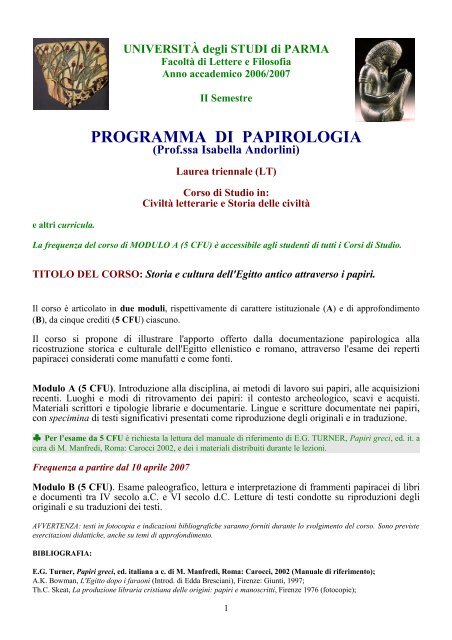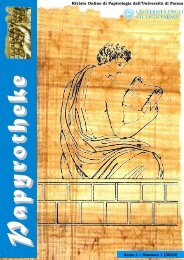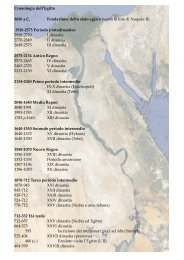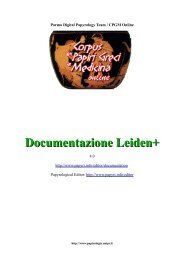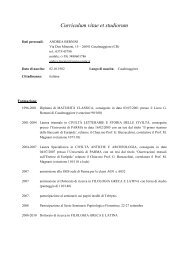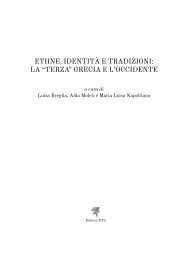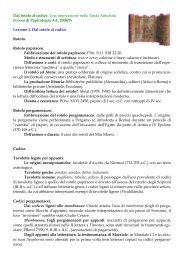Programma con Bibliografia generale e letture facoltative consigliate
Programma con Bibliografia generale e letture facoltative consigliate
Programma con Bibliografia generale e letture facoltative consigliate
You also want an ePaper? Increase the reach of your titles
YUMPU automatically turns print PDFs into web optimized ePapers that Google loves.
UNIVERSITÀ degli STUDI di PARMA<br />
Facoltà di Lettere e Filosofia<br />
Anno accademico 2006/2007<br />
II Semestre<br />
e altri curricula.<br />
PROGRAMMA DI PAPIROLOGIA<br />
(Prof.ssa Isabella Andorlini)<br />
Laurea triennale (LT)<br />
Corso di Studio in:<br />
Civiltà letterarie e Storia delle civiltà<br />
La frequenza del corso di MODULO A (5 CFU) è accessibile agli studenti di tutti i Corsi di Studio.<br />
TITOLO DEL CORSO: Storia e cultura dell'Egitto antico attraverso i papiri.<br />
Il corso è articolato in due moduli, rispettivamente di carattere istituzionale (A) e di approfondimento<br />
(B), da cinque crediti (5 CFU) ciascuno.<br />
Il corso si propone di illustrare l'apporto offerto dalla documentazione papirologica alla<br />
ricostruzione storica e culturale dell'Egitto ellenistico e romano, attraverso l'esame dei reperti<br />
papiracei <strong>con</strong>siderati come manufatti e come fonti.<br />
Modulo A (5 CFU). Introduzione alla disciplina, ai metodi di lavoro sui papiri, alle acquisizioni<br />
recenti. Luoghi e modi di ritrovamento dei papiri: il <strong>con</strong>testo archeologico, scavi e acquisti.<br />
Materiali scrittori e tipologie librarie e documentarie. Lingue e scritture documentate nei papiri,<br />
<strong>con</strong> specimina di testi significativi presentati come riproduzione degli originali e in traduzione.<br />
♣ Per l’esame da 5 CFU è richiesta la lettura del manuale di riferimento di E.G. TURNER, Papiri greci, ed. it. a<br />
cura di M. Manfredi, Roma: Carocci 2002, e dei i materiali distribuiti durante le lezioni.<br />
Frequenza a partire dal 10 aprile 2007<br />
Modulo B (5 CFU). Esame paleografico, lettura e interpretazione di frammenti papiracei di libri<br />
e documenti tra IV secolo a.C. e VI secolo d.C. Letture di testi <strong>con</strong>dotte su riproduzioni degli<br />
originali e su traduzioni dei testi.<br />
AVVERTENZA: testi in fotocopia e indicazioni bibliografiche saranno forniti durante lo svolgimento del corso. Sono previste<br />
esercitazioni didattiche, anche su temi di approfondimento.<br />
BIBLIOGRAFIA:<br />
E.G. Turner, Papiri greci, ed. italiana a c. di M. Manfredi, Roma: Carocci, 2002 (Manuale di riferimento);<br />
A.K. Bowman, L'Egitto dopo i faraoni (Introd. di Edda Bresciani), Firenze: Giunti, 1997;<br />
Th.C. Skeat, La produzione libraria cristiana delle origini: papiri e manoscritti, Firenze 1976 (fotocopie);<br />
1
G. Cavallo, La nascita del codice, SIFC, ser. III/3 (1985), 118-121;<br />
N. Lewis, Greeks in Ptolemaic Egypt, Oxford: Clarendon Press, 1986 (cap. 7)<br />
R.S. Bagnall, Reading Papyri, Writing Ancient History, London and New York: Routledge, 1995 (pagine scelte);<br />
H. Maehler, Alessandria, il Museo, e la questione dell'identità culturale, in Atti della Accademia Nazionale dei Lincei, v.XIV<br />
(2003), 99-120.<br />
♣ Per l'esame di chi abbia frequentato i moduli A e B (10 CFU), è richiesta, oltre alla lettura del manuale di<br />
riferimento (E.G. TURNER, Papiri greci, ed. it. a cura di M. Manfredi, Roma: Carocci 2002), e di almeno 3 saggi<br />
tra quelli <strong>con</strong>sigliati in <strong>Bibliografia</strong>, una presentazione esauriente (lettura, traduzione e commento) dei testi su<br />
papiro analizzati durante il corso e dei materiali scrittori illustrati.<br />
È facoltativa la <strong>con</strong>segna di un sintetico elaborato finale, <strong>con</strong>sistente in un'esercitazione su un papiro a<br />
scelta, <strong>con</strong>cordato col docente.<br />
AVVERTENZA: testi in fotocopia e ulteriori indicazioni bibliografiche saranno forniti durante lo svolgimento del corso. Sono<br />
previste esercitazioni didattiche, anche su temi di approfondimento.<br />
Laurea specialistica biennale (SP)<br />
Corso di Studio in:<br />
Civiltà antiche e Archeologia<br />
(5 CFU)<br />
Frequenza a partire dal 10 aprile 2007 per chi non abbia mai frequentato un modulo di<br />
papirologia.<br />
TITOLO DEL CORSO: Letteratura e documenti dagli archivi papiracei del villaggio di<br />
Tebtynis in Egitto.<br />
Corso per la Laurea specialistica (SP, 5 CFU). Coincide in parte col Modulo B del Corso per<br />
la Laurea triennale.<br />
Vita e cultura, storia ed amministrazione di un villaggio egiziano tra età tolemaica ed età romana.<br />
Il <strong>con</strong>testo archeologico e la storia degli scavi. Esame paleografico, lettura e interpretazione di<br />
una scelta di papiri, <strong>con</strong> approfondimenti ed esercitazioni sui reperti degli archivi di Tebtynis<br />
(Faiyum) in Egitto. Letture <strong>con</strong>dotte su riproduzioni degli originali e in traduzione.<br />
AVVERTENZA: testi in fotocopia e bibliografia saranno forniti durante lo svolgimento del corso. Sono previste esercitazioni<br />
didattiche, e seminari di gruppo su papiri inediti (= Seminario Papirologico su testi inediti 2006/2007).<br />
2
BIBLIOGRAFIA:<br />
E.G. Turner, Papiri greci, ed. italiana a c. di M. Manfredi, Roma: Carocci, 2002;<br />
A.K. Bowman, L'Egitto dopo i faraoni (Introd. di Edda Bresciani), Firenze: Giunti, 1997;<br />
Th.C. Skeat, La produzione libraria cristiana delle origini: papiri e manoscritti, Firenze 1976 (fotocopie);<br />
G. Cavallo, La nascita del codice, SIFC, ser. III/3 (1985), 118-121;<br />
N. Lewis, Life in Egypt under Roman Rule, Oxford: Clarendon Press, 1983<br />
N. Lewis, Greeks in Ptolemaic Egypt, Oxford: Clarendon Press, 1986 (cap. 7: Upward Mobility in the Civil Service: Menkhes,<br />
Village Clerk)<br />
A.E. Hanson, Papyrology: A Discipline in Flux (in G.W. Most, Ed., Disciplining Classics – Altertumswissenschaft als Beruf,<br />
Göttingen 2002 = Aporemata 6), 191-206.<br />
In particolare:<br />
D. Foraboschi, L'archivio di Kronion, Milano: Cisalpino-Goliardica, 1971<br />
C. Gallazzi, "La "Cantina dei Papiri" di Tebtynis e ciò che essa <strong>con</strong>teneva," Zeitschrift für Papyrologie und Epigraphik 80<br />
(1990), 283-288 + Taf. XVIII<br />
C. Gallazzi, La ricerca archeologica a Umm el-Breigât, in Maria Casini (ed.), Cento anni in Egitto. Percorsi dell’archeologia<br />
italiana, Milano: Electa, 2001, 171-83<br />
P. Davoli, L' archeologia urbana nel Fayyum di età ellenistica e romana, Missione <strong>con</strong>giunta delle Università di Bologna e di<br />
Lecce in Egitto, Athenaeum, Naples, 1998<br />
R.S. Bagnall, Village and Urban Elites in Roman Tebtunis (2000)<br />
(paper online at http://ist-socrates.berkeley.edu/~tebtunis/ancientlives/bagnall.html)<br />
D.J. Thompson, The Greek Frontier: Settlers in the South Fayum<br />
(paper online at http://ist-socrates.berkeley.edu/~tebtunis/ancientlives/thompson.html)<br />
A. Verhoogt, From Mummy to Megabyte<br />
(paper online at http://ist-socrates.berkeley.edu/~tebtunis/ancientlives/verhoogt.html)<br />
I. Andorlini, Un ricettario da Tebtynis: parti inedite di PSI 1180, in Testi medici su papiro. Atti dell'in<strong>con</strong>tro di studio<br />
(Firenze, 3-4 giugno 2002), a c. di I. Andorlini, Firenze, Istituto Papirologico "G. Vitelli" 2004 (Progetto Corpus dei<br />
Papiri Greci di Medicina), 81-118<br />
A.E. Hanson, Greek Medical Papyri from Tebtunis: A local health-care system that was in part patient driven?, in Ph. van der<br />
Eijk (ed.), "Hippocrates in Context. Papers Read at the XIth International Hippocrates Colloquium (University of<br />
Newcastle upon Tyne, 28-30 August 2002)", Leiden: Brill, 2005, 387-402<br />
♣ Per l’esame da 5 CFU (SP) sono richiesti:<br />
1. Tavole e testi per il corso di Papirologia dell’a.a. 2006/07 distribuiti durante le lezioni.<br />
2. E.G. TURNER, Papiri greci, ed. it. a cura di M. Manfredi, Roma: Carocci 2002 (e 3 <strong>letture</strong> tra quelle <strong>con</strong>sigliate in<br />
BIBLIOGRAFIA e durante il corso).<br />
3. Un'esercitazione scritta su un papiro a scelta (relazione o trascrizione), <strong>con</strong> tema da <strong>con</strong>cordare col docente.<br />
Nella se<strong>con</strong>da parte del Semestre è previsto, per studenti<br />
avanzati, specializzandi, dottorandi e dottori di ricerca,<br />
un nuovo ciclo di lezioni e attività per il:<br />
Seminario Papirologico 2007 su papiri inediti dagli<br />
archivi di Tebtynis, nel Fayûm.<br />
Rilievo templare tolemaico da Tebtynis: il dio Sobek ed un sovrano dei<br />
Tolemei<br />
3
BIBLIOGRAFIA GENERALE<br />
e <strong>letture</strong> <strong>facoltative</strong> <strong>con</strong>sigliate<br />
(* LT, modulo A; ** LT, modulo B; *** LS)<br />
I. MANUALI<br />
*E.G. TURNER, Papiri greci, ed. it. a c. di M. Manfredi, Roma: Carocci, 2002 2 [ed.orig. Greek Papyri, Oxford<br />
1980 2 ]<br />
O. MONTEVECCHI, La Papirologia, Milano: Vita e Pensiero 1988 2 (1 a ed. Torino 1973)<br />
***A.K. BOWMAN, L'Egitto dopo i faraoni (Introd. di E. Bresciani), ed. it., Firenze: Giunti 1997 (ed. orig. 1986)<br />
H.-A. RUPPRECHT, Introduzione alla Papirologia, ed. it. a c. di L. Migliardi Zingale, Torino: G. Giappichelli 1999<br />
Egypt From Alexander to the Copts. An Archaeological and Historical Guide. Edited by R.S. BAGNALL and D.W.<br />
RATHBONE, London: BritMus Press 2004<br />
M. CAPASSO, Introduzione alla papirologia, Bologna: Il Mulino 2005<br />
Ia. ALTRE OPERE MANUALISTICHE, SAGGI su ‘archivi e biblioteche’ e sviluppi recenti<br />
della ‘papirologia’<br />
<strong>Bibliografia</strong>: Liber antiquus: bibliographie générale par Jean-Christophe Didderen:<br />
http://www.ulg.ac.be/facphl/services/cedopal/pages/bibliographies/Liber%20antiquus.htm<br />
The Leuven Homepage of Papyrus Archives and Collections:<br />
http://lhpc.arts.kuleuven.ac.be/archives/introduction.html<br />
***E.G. TURNER, Scribes and scholars of Oxyrhynchus, in Mitt. Papyr. Österr. Nation. (Papyrus Erzherzog Rainer, N.S. Wien<br />
1956), 141-146<br />
H.C. YOUTIE, Papyrologist, Artificer of Fact, GRBS 4, 1963, 24 ss. (= Scriptiunculae vol. 1, 1 ss.)<br />
***E.G. TURNER, The Papyrologist at Work, GRBS Monograph 6, 1973<br />
H.C. YOUTIE, The Textual Criticism of Documentary Papyri: Prolegomena, 2nd ed., BICS Suppl. 33, 1974<br />
G. CAVALLO (a cura di), Libri, editori e pubblico nel mondo antico, Bari 1977 2<br />
**W. CLARYSSE, Literary Papyri in Documentary “Archives”, Studia Hellenistica 27 (Lovanii 1983), 43–61<br />
A. BLANCHARD (édité par), J. Irigoin (préf. de), Les débuts du codex. Actes de la journée d'étude organisée à Paris par l'Institut<br />
de Papyrologie de la Sorbonne et l'Institut de Recherche et d'Histoire des Textes (3-4.VII.1985), Turnhout, Brepols,<br />
1989 (= Bibliologia, 9)<br />
É. LALOU (éd. par), Les tablettes à écrire de l'Antiquité à l'Époque Moderne. Actes du colloque international du CNRS (Paris,<br />
Institut de France, 10-11 octobre 1990) organisé par l'Institut de Recherche et d'Histoire des Textes et par l'Institut de<br />
Papyrologie de la Sorbonne, Turnhout, Brepols, 1992 (= Bibliologia, 12).<br />
**A. MARTIN, Archives privées et cachettes documentaires, in Proceedings of the 20th International Congress of Papyrologists<br />
(Copenhagen, 1994), 569-577<br />
R.S. BAGNALL, Egypt in Late Antiquity, Princeton 1993<br />
R.S. BAGNALL, Reading Papyri, Writing Ancient History, London & New York: Routledge, 1995<br />
**Le biblioteche nel mondo antico e medievale, a c. di G. Cavallo, Bari: BUL 250, 1993 (Introd.; cap. I)<br />
**R. OTRANTO, Antiche liste di libri su papiro, Roma: Edizioni di storia e letteratura, 2000 (Sussidi Eruditi, 49) (introd.)<br />
**A.E. HANSON, Papyrology: Minding Other People's Business, in TAPhA 131 (2001), 297-313<br />
**A.E. HANSON, Papyrology: A Discipline in Flux (in G.W. Most, Ed., Disciplining Classics – Altertumswissenschaft als Beruf,<br />
Göttingen 2002 = Aporemata 6), 191-206<br />
***W. CLARYSSE, Tomoi synkollesimoi, in: M. BROSIUS (Hg.), Ancient Archives and Archival Traditions. Concepts of Record-<br />
Keeping in the Ancient World, Oxford 2003<br />
H. Maehler, Alessandria, il Museo, e la questione dell'identità culturale, in Atti della Accademia Nazionale dei Lincei, v.XIV<br />
(2003), 99-120.<br />
II. PALEOGRAFIA. Raccolte di tavole <strong>con</strong> riproduzioni di testi.<br />
F. G. KENYON, The Palaeography of Greek Papyri, London 1899<br />
W. SCHUBART, D.H. LIETZMANN, Papyri Graecae Berolinenses, Bonn, 1911, 50 pl. et 34 p. (Tabulae in usum scholarum, 2)<br />
M. NORSA, Papiri greci delle collezioni italiane. Scritture documentarie, I-III, Roma 1929–1946<br />
M. NORSA, La scrittura letteraria greca dal secolo IV a.C. all'VIII d.C., Firenze 1939<br />
C. H. ROBERTS, Greek Literary Hands, 350 B.C. - A.D. 400, Oxford 1956<br />
G. CAVALLO, Ricerche sulla maiuscola biblica, Firenze 1967 (STP 2)<br />
E. BOSWINKEL – P.J. SIJPESTEIN, Greek Papyri, Ostraca and Mummy Labels, Amsterdam, 1968, 54 pl. (Tabulae palaeographicae,<br />
1)<br />
4
R. SEIDER, Paläographie der griechischen Papyri, 3 vol., Stuttgart, 1967-1990. Band III, 1. Text. Erster Teil. Urkundenschrift I.<br />
Mit einer Vorgeschichte zur Paläographie der griechischen Papyri, Stuttgart, 1990<br />
**G. CAVALLO, Note sulla scrittura greca corsiva dei papiri, “Scriptorium” 22 (1968), 291-294<br />
**G. CAVALLO, Note sulla scrittura greca libraria dei papiri, “Scriptorium” 26 (1972), 71-76<br />
R. SEIDER, Paläographie der lateinischen Papyri, 3 vol., Stuttgart, 1972-1981<br />
**G. CAVALLO, La nascita del codice, SIFC, ser. III/3 (1985), 118-121<br />
E.G. TURNER, Greek Manuscripts of the Ancient World, 2nd Rev. Ed. by P. J. Parsons, London 1987 (University of London.<br />
Institute of Classical Studies. Bulletin Supplement, 46 [= BICS]) = GMAW 2<br />
G. CAVALLO – H. MAEHLER, Greek Bookhands of the Early Byzantine Period: A.D. 300-800, London 1987 (University of<br />
London. Institute of Classical Studies. Bulletin Supplement, 47)<br />
G. CAVALLO et alii (a cura di), Scrivere libri e documenti nel mondo antico (Papyrologica Florentina 30), Firenze 1998<br />
G. CAVALLO, Il calamo e il papiro. La scrittura greca dall'età ellenistica ai primi secoli di Bisanzio (Papyrologica Florentina<br />
36), Firenze 2005<br />
III. MATERIALI SCRITTORI<br />
**TH.C. SKEAT, La produzione libraria cristiana delle origini: papiri e manoscritti, Firenze 1976<br />
N. LEWIS, Papyrus in Classical Antiquity, Oxford 1974.<br />
N. LEWIS, Papyrus in Classical Antiquity. A Supplement, Bruxelles 1989<br />
C. H. ROBERTS - Th. C. SKEAT, The Birth of the Codex, London 1983<br />
E. G. TURNER, The Typology of the Early Codex, Philadelphia 1977<br />
E. G. TURNER, ‘Recto’ e ‘Verso’. Anatomia del rotolo di papiro, trad. it., Firenze 1994 (ed orig. The Terms Recto and Verso,<br />
Pap.Brux. 16, 1978)<br />
H. BLANCK, Das Buch in der Antike, München 1992<br />
***G. CAVALLO, Tra «Volumen» e «Codex». La lettura nel mondo romano, in Storia della lettura, a c. di G. CAVALLO e R.<br />
CHARTIER, Bari: Laterza 1995, 37-69<br />
W.A. JOHNSON, Bookrolls and Scribes in Oxyrhynchus, University of Toronto Press 2004<br />
IV. SILLOGI DI TESTI SU PAPIRO (anche <strong>con</strong> traduzioni moderne)<br />
L. MITTEIS, U. WILCKEN, Grundzüge und Chrestomathie der Papyrusurkunde, Leipzig and Berlin 1912; I. Historischer Teil (U.<br />
Wilcken). v.1: Grundzüge; v.2: Chrestomathie II. Juristischer Teil (L. Mitteis). v.1: Grundzüge; v.2: Chrestomathie<br />
A.S. HUNT - C.C. EDGAR - D.L. PAGE, Select Papyri, I-III, Cambridge Mass. - London 1932-1950 (vol. 1: Non-Literary Papyri,<br />
Private Documents; vol. 2: Non-Literary Papyri, Public Documents; vol. 3: D.L. PAGE (ed.), Literary Papyri: Poetry,<br />
Cambridge, 1941)<br />
J. HENGSTL, Griechische Papyri aus Ägypten, München 1978.<br />
M. DAVID - B.A. Van GRONINGEN - P.W. PESTMAN, The New Papyrological Primer, Leiden-New York-Köln, rist. 1994 (ed.<br />
1990 5 )<br />
M. NALDINI, Il cristianesimo in Egitto, Firenze 1968<br />
G. TIBILETTI, Lettere private nei papiri greci dell III e IV secolo d.c.tra paganesimo et cristianesimo, Milano 1979<br />
V. DIZIONARI E REPERTORI, Geografia, Onomastica. Grammatica<br />
J. F. OATES & alii, Checklist of Editions of Greek Papyri and Ostraca, Atlanta 1992 4<br />
R. A. PACK, The Greek and Latin Literary Texts from Greco-Roman Egypt, Ann Arbor 1965 2<br />
F. PREISIGKE, Namenbuch, Heidelberg 1922 (agg. D. FORABOSCHI, Onomasti<strong>con</strong> Alterum Papyrologicum, Milano 1967)<br />
F. PREISIGKE, Wörterbuch der griechischen Papyrusurkunden, I-III, Berlin 1925-1931<br />
Supplement 1, agg. E. Kiessling, I-III, Amsterdam 1969-1971<br />
Supplement 2 (1967-1976), Rupprecht H.-A., Jördens A., Wiesbaden 1991<br />
Supplement 3 (1977-1988), Rupprecht H.-A., Jördens A., Wiesbaden 2000<br />
P. KRETSCHMER - E. LOCKER, Rückläufiges Wörterbuch der griechischen Sprache, Göttingen 1944<br />
W. PEREMANS – E. van T'DACK, Prosopographia Ptolemaica = Studia Hellenistica 6, 1950 (= pt. i); 8, 1952 (= pt. ii); 11, 1956 (=<br />
pt. iii); 12, 1959 (= pt. iv); 13, 1963 (= pt. v) →<br />
F. DORNSEIFF, B. HANSEN, Reverse-Lexi<strong>con</strong> of Greek Proper Names (= reprint of Rückläufiges Wörterbuch der griechischen<br />
Eigennamen, Sachsichen Akad. d. Wiss. zu Leipzig, Berlin 1957), Chicago 1978<br />
PAPE-BENSELER, Wörterbuch der griechischen Eigennamen, Oxford 1911 (1959 edition with additions by BENSELER, G.)<br />
P.M. FRAZER – E. MATTHEWS, A Lexi<strong>con</strong> of Greek Personal Names, Oxford 1987 <br />
Berichtigungsliste der griechischen Papyrusurkunden aus Ägypten (= BL). 1922, Fr. Preisigke, vol. 1-11 →<br />
E. MAYSER, Grammatik d. griech. Papyri aus d. Ptolemäerzeit, Berlin - Leipzig 1906-1938<br />
F. GIGNAC, A Grammar of the Greek Papyri of the Roman and Byzantine Periods, v. 1: Phonology, Milano 1976; v.2:<br />
Morphology, Milano 1981<br />
B. MANDILARAS, The Verb in the Greek Non-Literary Papyri, Athens 1973<br />
J.H. MOULTON, A Grammar of the New Testament; 3 voll., Edinburg 1908, 1919, 1963; vol. 3 by N.Turner<br />
G. RONCHI, Lexi<strong>con</strong> Theonymon, 5 voll., Milano 1974-77<br />
5
A. CALDERINI - S. DARIS, Dizionario dei nomi geografici e topografici dell' Egitto greco- romano, <strong>con</strong> Supplemento I, Milano<br />
1935 (<strong>con</strong>tinua) <br />
G.W.H. LAMPE, A Patristic Greek Lexi<strong>con</strong>, Oxford 1963-1969<br />
W. BAUER, Griechisch-deutsches Wörterbuch zu den Schriften des Neuen Testaments und der frühchristlichen Literatur, Berlin<br />
1988<br />
Sammelbuch griechischer Urkunden aus Ägypten (F. Preisigke, et alii), Marburg 1915 → (= SB)<br />
WL-2006: WörterListen (D. Hagedorn, Hg., Heidelberg); Kontr.WL<br />
VI. CRONOLOGIA<br />
T.C. SKEAT, The Reigns of the Ptolemies, Münch. Beitr. 39, München 1954<br />
A.E. SAMUEL, Ptolemaic Chronology, Münch. Beitr. 43, München 1962<br />
P. BURETH, Les titulatures impériales dans les papyrus, les ostraca, et les inscriptions d'Égypte 30 a.C.-284 p.C., Bruxelles<br />
1964 = Pap.Brux. 2<br />
P.W. PESTMAN, Chronologie Egyptienne d' après les textes démotiques (332 av. J.-C. - 453 ap. J.-C.), Pap. Lugd.-Bat. 15,<br />
Leiden 1967 (vedi anche Preisigke, WB vol. III Abschn. 2; Rupprecht, WB. Supplement 2. Abschn. 2B)<br />
J.-Cl. GRENIER, Les titulatures des empereurs romains dans les documents en langue égyptienne, Pap.Brux. 22, 1989<br />
R.S. BAGNALL, K.A. WORP, Regnal formulas in Byzantine Egypt, BASP Suppl. 2, 1979<br />
R.S. BAGNALL, et al., Consuls of the Later Roman Empire, Atlanta 1987<br />
M. PEACHIN, Roman Imperial Titulature and Chronology, A.D. 235-284, Stud.Amst. 29, 1990<br />
P.W. PESTMAN et al., A Guide to the Zenon Archive, Pap.Lugd.-Bat. 21a, Leiden 1981<br />
T.C. SKEAT, The Reign of Augustus in Egypt: Conversion Tables for the Egyptian and Julian Calendars, 30 B.C. - 14 A.D.,<br />
Münch. Beitr. 84, München 1993<br />
R.S. BAGNALL, K.A. WORP, The Chronological Systems of Byzantine Egypt, Leiden 2004 (2nd ed.)<br />
VII. PAPIRI LETTERARI<br />
R.A. PACK, The Greek and Latin Literary Texts from Graeco-Roman Egypt, 2e éd., Ann Arbor, 1965 2 : ora MERTENS-PACK 3<br />
du Centre de Documentation de Papyrologie littéraire (CEDOPAL) de l'Université de Liège<br />
http://promethee.philo.ulg.ac.be/cedopal/indexcombineeauteur.asp<br />
Leuven Data-Base of Ancient Books (LDAB) (circa 11.000 dati): http://ldab.arts.kuleuven.be/<br />
J. Van HAELST, Catalogue des papyrus littéraires juifs et chrétiens, Paris, 1976, 424 p. (Université de Paris IV. Paris-Sorbonne.<br />
Série Papyrologie, 1)<br />
K. ALAND, Repertorium der griechischen christlichen Papyri, Berlin 1976 (aggiornamenti in APF, C. Römer)<br />
PAPIRI ERCOLANESI<br />
M. GIGANTE, Catalogo dei papiri Ercolanesi, Napoli, 1979<br />
G. CAVALLO, Libri scritture scribi a Ercolano, Napoli: Macchiaroli 1983 (CrErc Suppl. 13)<br />
M. CAPASSO, Manuale di Papirologia Ercolanese, Galatina: Congedo 1991<br />
DEL MASTRO, Chartes. Catalogo Multimediale dei Papiri Ercolanesi. A cura di Gianluca Del Mastro. 2005: Il Catalogo offre<br />
possibilità di ricerca tra più di 3500 pubblicazioni sui Papiri Ercolanesi e più di 25000 informazioni riguardanti le<br />
caratteristiche e la storia di tali rotoli.<br />
CISPE (Napoli): Centro Internazionale per lo Studio dei Papiri Ercolanesi, ora intitolato a M. Gigante (C.I.S.P.E.)<br />
http://www.cispegigante.it/frame.asp<br />
The Friends of Herculaneum Society (Oxford) http://www.herculaneum.ox.ac.uk/<br />
VIII. SIGLE E ABBREVIAZIONI<br />
Convenzioni per la trascrizione dei papiri (fissate nel 1931); per ulteriori Raccomandazioni, vedi Chronique d'Égypte 43<br />
(1968) No. 85, p. 212 e Chronique d'Égypte 43 (1968) No. 86, p. 45 e il sito della AIP:<br />
http://www.ulb.ac.be/assoc/aip/recomman.htm<br />
( ) soluzione o scioglimento di simbolo o abbreviazione<br />
[ ] interruzione di testo (lacuna); il testo è talora integrato dall'editore<br />
< > errore od omissione dello scriba<br />
{ } lettera o lettere superflue presenti nel testo originale, omesse dall'editore per ottenere un testo corretto<br />
[[ ]] lettera o lettere cancellate dallo scriba<br />
\ / inserimento sul rigo (supra lineam)<br />
vac. = vacat, indica che il papiro è bianco (= non scritto) in quel punto<br />
. . . i punti sotto le lettere indicano una lettura incerta; da soli indicano la presenza di tracce non decifrabili.<br />
K. MCNAMEE, Abbreviations in Greek Literary Papyri and Ostraca, BASP Suppl. 3, Chicago 1981<br />
6
K. MCNAMEE, Sigla and Select Marginalia in Greek Literary Papyri, Pap.Brux. 26, 1992<br />
A. H. R. E. PAAP, Nomina Sacra in the Greek Papyri of the First Five Centuries, Pap.Lugd.-Bat. 8, Leiden 1959<br />
Per i papiri documentari:<br />
O. MONTEVECCHI, La Papirologia, 476 s.<br />
P.Lond. III, Index (p. 344 ss.)<br />
A.BLANCHARD, Sigles et abreviations dans les papyrus documentaires grecs, BICS Suppl. 30, 1974<br />
IX. COLLEZIONI PAPIROLOGICHE<br />
J. F. OATES & alii, Checklist of Editions of Greek Papyri and Ostraca, Atlanta 1992 4<br />
http://scriptorium.lib.duke.edu/papyrus/texts/clist.html<br />
W. CLARYSSE et alii, Papyrus Collections World Wide(9–10 March 2000): http://lhpc.arts.kuleuven.ac.be/collections/index.html<br />
X. RIVISTE SPECIALISTICHE<br />
Aegyptus. Rivista italiana di egittologia e papirologia (Milano).<br />
Analecta Papyrologica (Messina)<br />
Archiv für Papyrusforschung und verwandte Gebiete (Stuttgart-Leipzig). APF.<br />
The Bulletin of the American Society of Papyrologists (diversi luoghi d'edizione). BASP.<br />
Chronique d'Égypte (Bruxelles). CE.<br />
Journal of Egyptian Archaeology (London). JEA.<br />
Journal of Juristic Papyrology (Varsovie). JJP.<br />
Papyrologica Lupiensia (Lecce). PL.<br />
Tyche. Beiträge zur alten Geschichte. Papyrologie und Epigraphik (Wien).<br />
Zeitschrift für Papyrologie und Epigraphik (Bonn): http://www.uni-koeln.de/phil-fak/ifa/zpe/index.html<br />
XI. RISORSE ELETTRONICHE<br />
vedi Association Internationale de Papyrologues (Links) = AIP<br />
http://www.ulb.ac.be/assoc/aip/<br />
vedi Rassegna degli Strumenti Informatici per lo Studio dell'Antichità Classica (Fonti papiracee)<br />
http://www.rassegna.unibo.it/papiri.html<br />
Bibliographie Papyrologique: CD-ROM 'Subsidia papyrologica 2.0', <strong>con</strong>tenente la Bibliographie Papyrologique dal 1931 al<br />
2005. http://www.ulb.ac.be/philo/cpeg/bp.htm<br />
Checklist of Editions of Greek, Latin, Demotic and Coptic Papyri, Ostraca and Tablets<br />
http://scriptorium.lib.duke.edu/papyrus/texts/clist.html<br />
APIS: Advanced Papyrology Information System (APIS represents a <strong>con</strong>sortium of six universities with papyrus collections:<br />
Columbia, Duke, Princeton, Berkeley, University of Michigan, and Yale)<br />
http://www.columbia.edu/cu/lweb/projects/digital/apis/index.html<br />
Oxford (CSAD): Centre for the Study of Ancient Documents http://www.csad.ox.ac.uk/. → POxy: Oxyrhynchus Online:<br />
http://www.papyrology.ox.ac.uk/<br />
Institut fur Papyrologie der Universitat Heidelberg: Heidelberger Gesamtverzeichnis der griechischen<br />
Papyrusurkunden Ägyptens (circa 48.000 documenti) http://www.rzuser.uni-heidelberg.de/~gv0/gvz.html<br />
Duke Databank of Documentary Papyri (DDBDP, Perseus). PHI CD-ROM #7, 1996<br />
http://odyssey.lib.duke.edu/papyrus/texts/DDBDP.html<br />
TLG Thesaurus Linguae Graecae Project. TLG CD-RO#D, 1991; #E, 1999. → TLG online Version<br />
LDAB 1998 (CD-ROM): W. Clarysse, The Leuven Data-Base of Ancient Books (= LDAB) → online Version (circa 11.000<br />
dati, testi greci e latini) http://ldab.arts.kuleuven.be/index.html<br />
WL-2006: WörterListen (D. Hagedorn, Hg., Heidelberg); Kontr.WL (Elenchi di parole di volumi recenti di papiri e ostraca,<br />
compilati sotto la direzione di D. HAGEDORN: include le pubblicazioni non comprese nel CD-ROM del DDBDP. Si tratta di un<br />
Adobe Acrobat .pdf file, scaricabile a<br />
http://www.papy.uni-hd.de/WL/WL.html<br />
Iscrizioni: The Packard Humanities Institute PHI#5. Ora vedi: Greek Epigraphy Project: Browse Inscriptions:<br />
http://epigraphy.packhum.org/inscriptions/<br />
Orario delle lezioni (che si svolgono in Aula A2 del Plesso D'Azeglio):<br />
Martedì: 16,15 – 18<br />
Mercoledì: 16,15 – 18<br />
Giovedì: 12,15 – 14<br />
7


